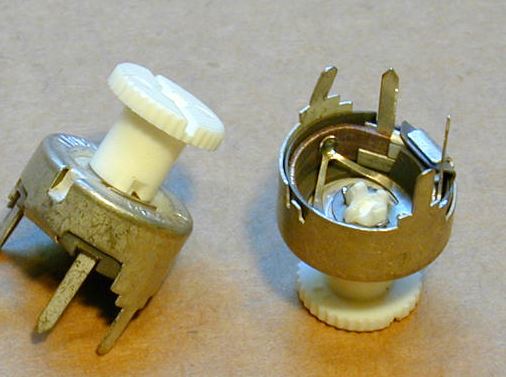02-04-2025, 10:06 PM
Hi MartinJ,
It is in fact a wirewound variable resistor, sometimes known as a rheostat, but others call it a "pot" (Short for potentiometer). Potentiometer usually refers to a high resistance carbon resistor type, such as a volume control, and usually with a resistance between 5KOhm and 2MegOhm. Rheostat usually refers to a wirewound type of relatively low resistance (say, less than 1000 Ohm), similar to the ones used to control filament voltage in battery operated radios of the early 1920s. Edited 02/04/25 to normalize to Morzh's post which is a better definition.
The one in your set is likely of rather low resistance, wirewound and likely handles more than 1/2 Watt but likely less than 5 Watts. If only 2 connections (one end of the resistance element and the wiper), it is referred to as a rheostat. If it has 3 connections (both ends of the resistance element and the wiper0, it is referred to as a potentiometer. The physical type in your picture was somewhat common in some TV sets, especially in the convergence section of color sets of the 50s and 60s, and in other places where a low resistance variable resistor is needed with higher wattage dissipation than a carbon style pot, particularly one that will not be adjusted frequently.
Attached is a picture of one of these for an old RCA Color TV convergence board. In this particular one (and possibly yours) the wiper does not have its own pin; the wiper connects to the case. In addition, this type was designed to be mounted and soldered to a PC (Printed Circuit) board.

I suspect that given the rust, yours is total toast, but if you don't have the specs, take it out and ohm between the ends of the resistor. This particular style may not be available, but there should be a modern equivalent that will work.
What, specifically are you working on? We may be able to help with this and other issues and are very happy to do so!
It is in fact a wirewound variable resistor, sometimes known as a rheostat, but others call it a "pot" (Short for potentiometer). Potentiometer usually refers to a high resistance carbon resistor type, such as a volume control, and usually with a resistance between 5KOhm and 2MegOhm. Rheostat usually refers to a wirewound type of relatively low resistance (say, less than 1000 Ohm), similar to the ones used to control filament voltage in battery operated radios of the early 1920s. Edited 02/04/25 to normalize to Morzh's post which is a better definition.
The one in your set is likely of rather low resistance, wirewound and likely handles more than 1/2 Watt but likely less than 5 Watts. If only 2 connections (one end of the resistance element and the wiper), it is referred to as a rheostat. If it has 3 connections (both ends of the resistance element and the wiper0, it is referred to as a potentiometer. The physical type in your picture was somewhat common in some TV sets, especially in the convergence section of color sets of the 50s and 60s, and in other places where a low resistance variable resistor is needed with higher wattage dissipation than a carbon style pot, particularly one that will not be adjusted frequently.
Attached is a picture of one of these for an old RCA Color TV convergence board. In this particular one (and possibly yours) the wiper does not have its own pin; the wiper connects to the case. In addition, this type was designed to be mounted and soldered to a PC (Printed Circuit) board.
I suspect that given the rust, yours is total toast, but if you don't have the specs, take it out and ohm between the ends of the resistor. This particular style may not be available, but there should be a modern equivalent that will work.
What, specifically are you working on? We may be able to help with this and other issues and are very happy to do so!
"Do Justly, love Mercy and walk humbly with your God"- Micah 6:8
"Let us begin to do good"- St. Francis
Best Regards,
MrFixr55



![[-] [-]](https://philcoradio.com/phorum/images/bootbb/collapse.png)


